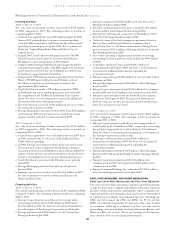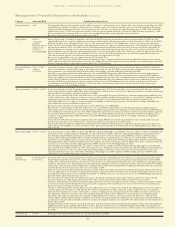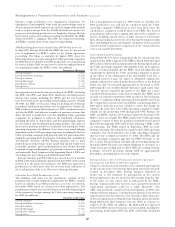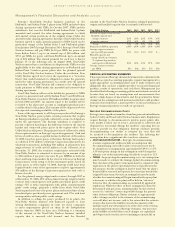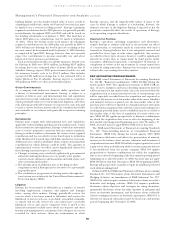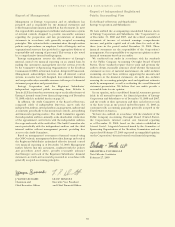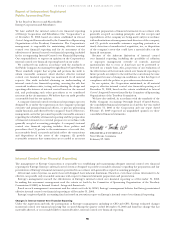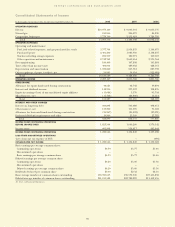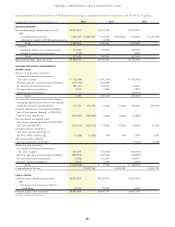Entergy 2008 Annual Report Download - page 49
Download and view the complete annual report
Please find page 49 of the 2008 Entergy annual report below. You can navigate through the pages in the report by either clicking on the pages listed below, or by using the keyword search tool below to find specific information within the annual report.
47
ENTERGY CORPORATION AND SUBSIDIARIES 2008
47
Management’s Financial Discussion and Analysis continued
47
Entergy’s rough production costs equalization calculation: (1)
elimination of interruptible loads from the methodology used to
allocate demand-related capacity costs; and (2) change of the method
used to re-price energy from the Vidalia hydroelectric project for
purposes of calculating production cost disparities. Entergy filed an
intervention and protest in this proceeding. In May 2007 the FERC
denied the LPSC’s complaint. The LPSC has requested rehearing,
and FERC consideration of that request is still pending.
2008 Rate Filing Based on Calendar Year 2007 Production Costs
In May 2008, Entergy filed with the FERC the rates for the second
year to implement the FERC’s orders in the System Agreement
proceeding. The filing, as amended in August 2008, shows the
following payments/receipts among the Utility operating companies
for 2008, based on calendar year 2007 production costs, commencing
for service in June 2008, are necessary to achieve rough production
cost equalization under the FERC’s orders (in millions):
Payments or (Receipts)
Entergy Arkansas $ 252
Entergy Gulf States Louisiana $(124)
Entergy Louisiana $ (36)
Entergy Mississippi $ (20)
Entergy New Orleans $ (7)
Entergy Texas $ (65)
Several parties intervened in the proceeding at the FERC, including
the APSC, the LPSC, and AmerenUE, which have also filed protests.
Several other parties, including the MPSC and the City Council,
have intervened in the proceeding without filing a protest. On July
29, 2008, the FERC set the proceeding for hearing and settlement
procedures. Settlement procedures were terminated on October 22,
2008. In direct testimony filed on January 9, 2009, certain intervenors
and also the FERC staff advocate a number of positions on issues that
affect the level of production costs the individual Utility operating
companies are permitted to reflect in the bandwidth calculation,
including the level of depreciation and decommissioning expense
for the nuclear and fossil-fueled generating facilities. The effect of
these various positions would be to reallocate costs among the Utility
operating companies. In addition, three issues were raised alleging
imprudence by the Utility operating companies, including whether the
Utility operating companies had properly reflected generating units’
minimum operating levels for purposes of making unit commitment
and dispatch decisions, whether Entergy Arkansas’ sales to third
parties from its retained share of the Grand Gulf nuclear facility were
reasonable, prudent, and non-discriminatory, and whether Entergy
Louisiana’s long-term Evangeline gas purchase contract was prudent
and reasonable. Reply testimony is due beginning March 6, 2009, and
a hearing in the proceeding is scheduled for June 2009.
Entergy Arkansas paid $36 million per month for seven months
in 2008, and began making the payments in June 2008. As discussed
in Note 2 to the financial statements, the APSC has approved a
production cost allocation rider for recovery from customers of
the retail portion of the costs allocated to Entergy Arkansas.
Calendar Year 2008 Production Costs
The liabilities and assets for the preliminary estimate of the
payments and receipts required to implement the FERC’s remedy
based on calendar year 2008 production costs were recorded in
December 2008, based on certain year-to-date information. The
preliminary estimate was recorded based on the following estimate
of the payments/receipts among the Utility operating companies
for 2009 (in millions):
Payments or (Receipts)
Entergy Arkansas $ 394
Entergy Gulf States Louisiana $ (67)
Entergy Louisiana $(156)
Entergy Mississippi $ (23)
Entergy New Orleans $ (–)
Entergy Texas $(148)
The actual payments/receipts for 2009, based on calendar year
2008 production costs, will not be calculated until the Utility
operating companies’ FERC Form 1s have been filed. Once the
calculation is completed, it will be filed at the FERC. The level of
any payments and receipts is significantly affected by a number of
factors, including, among others, weather, the price of alternative
fuels, the operating characteristics of the Entergy System generating
fleet, and multiple factors affecting the calculation of the non-fuel
related revenue requirement components of the total production
costs, such as plant investment.
Interruptible Load Proceeding
In April 2007 the U.S. Court of Appeals for the D.C. Circuit issued its
opinion in the LPSC’s appeal of the FERC’s March 2004 and April
2005 orders related to the treatment under the System Agreement of
the Utility operating companies’ interruptible loads. In its opinion,
the D.C. Circuit concluded that the FERC (1) acted arbitrarily and
capriciously by allowing the Utility operating companies to phase-
in the effects of the elimination of the interruptible load over a
12-month period of time; (2) failed to adequately explain why
refunds could not be ordered under Section 206(c) of the Federal
Power Act; and (3) exercised appropriately its discretion to defer
addressing the cost of sulfur dioxide allowances until a later time.
The D.C. Circuit remanded the matter to the FERC for a more
considered determination on the issue of refunds. The FERC issued
its order on remand in September 2007, in which it directs Entergy
to make a compliance filing removing all interruptible load from
the computation of peak load responsibility commencing April 1,
2004 and to issue any necessary refunds to reflect this change. In
addition, the order directs the Utility operating companies to make
refunds for the period May 1995 through July 1996. Entergy, the
APSC, the MPSC, and the City Council requested rehearing of the
FERC’s order on remand. The FERC granted the Utility operating
companies’ request to delay the payment of refunds for the period
May 1995 through July 1996 until 30 days following a FERC order
on rehearing. The FERC issued in September 2008 an order
denying rehearing. The refunds were made by the Utility operating
companies that owed refunds to the Utility operating companies
that were due a refund on October 15, 2008. The APSC and the
Utility operating companies appealed the FERC decisions to the
D.C. Circuit. The procedural schedule calls for briefing during the
first half of 2009. Because of its refund obligation to customers as a
result of this proceeding and a related LPSC proceeding, Entergy
Louisiana recorded provisions during 2008 of approximately
$16 million, including interest, for rate refunds.
Entergy Arkansas Notice of Termination of System Agreement
Participation and Related APSC Investigation
Citing its concerns that the benefits of its continued participation
in the current form of the System Agreement have been seriously
eroded, in December 2005, Entergy Arkansas submitted its
notice that it will terminate its participation in the current
System Agreement effective ninety-six (96) months from the date
of the notice or such earlier date as authorized by the FERC.
Entergy Arkansas indicated, however, that a properly structured
replacement agreement could be a viable alternative. The
APSC had previously commenced an investigation, in 2004, into
whether Entergy Arkansas’ continued participation in the System
Agreement is in the best interests of its customers. More than once
in the investigation proceeding Entergy Arkansas and its president,
Hugh McDonald, filed testimony with the APSC in response to
requests by the APSC. In addition, Mr. McDonald has appeared
before the APSC on more than one occasion at public hearings for
questioning. In December 2007, the APSC ordered Mr. McDonald








